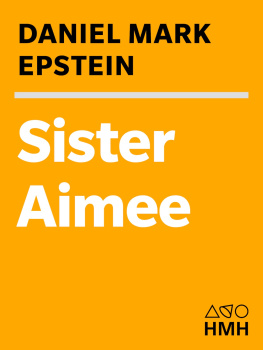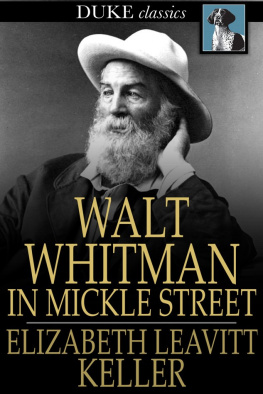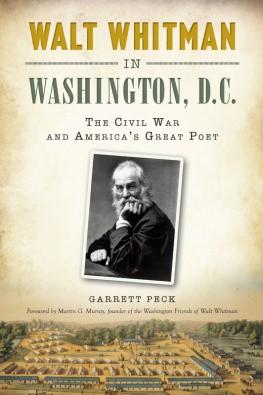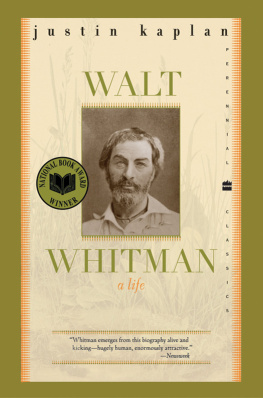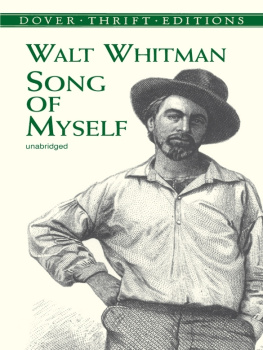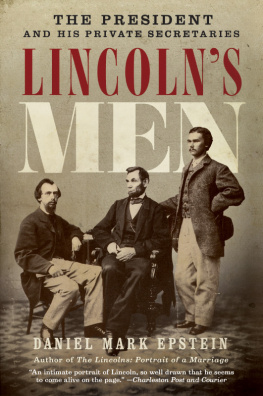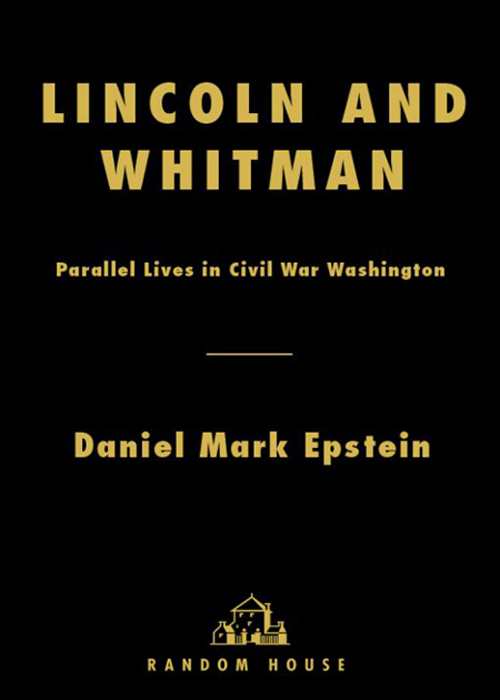
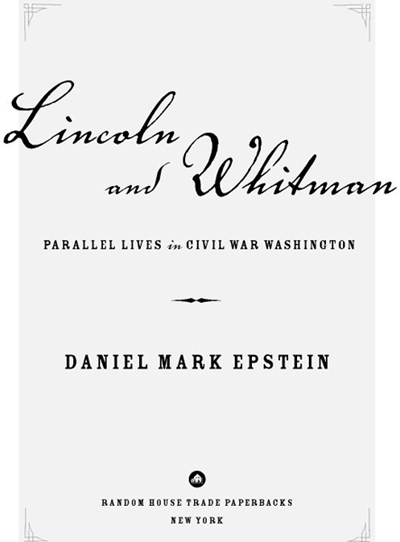
Table of Contents
For Neil Olson
PRAISE FOR Lincoln and Whitman
A revealing character study.
The Washington Post
Deftly written and carefully researched, this book uncovers fresh and often surprising connections between Americas greatest poet and its greatest statesman. Daniel Mark Epstein reveals a political side to Whitman and a literary side to Lincoln, finding new subtleties of character and skill in each of these towering figures. Along the way, he re-creates nineteenth-century life in fascinating ways.
David S. Reynolds,
author of Walt Whitmans America and Beneath the American Renaissance
Epstein presents a compelling affinity of ideas.
Newsday
Epstein offers a revealing character study of Whitman and a penetrating analysis of his wartime poetry.... [He] expertly paints the worlds in which Whitman moved, from Pfaff s saloon, where the poet enjoyed the bohemian camaraderie of the New York literati, to the military hospitals in Washington where he tended wounded soldiers.
The Ann Arbor News
Powerful and evocative.
Kirkus Reviews (starred review)
Epstein has yoked Lincoln and Whitman in a detailed narrative sure to please the vast audience both men justly command. The book is a fine combination of biography, history, and literary criticism, with several quirky excursions into the mysteries of the two mens lives and loves.
The Philadelphia Inquirer
An illuminating, elegant book. The scholarship is excellent, the ideas provocative, and the writing simply sublime. Both Lincoln and Whitmantogether with the long-vanished culture in which they livedcome vividly, sometimes startlingly, alive in Daniel Mark Epsteins luminous prose.
Harold Holzer,
author of The Lincoln Image
Cuts back and forth as compellingly as a good novel between evocative accounts of each man. The book places its two subjects in a uniquely sharp perspective.
The Burlington Free Press
Epstein memorably evokes the look and feel of Washington during the Civil War, the eerily adjacent lives there of Walt Whitman and Abraham Lincoln, and the frantic events that issued in the murder of our greatest president and the writing of our greatest poem, When Lilacs Last in the Dooryard Bloomd. Combining biography and history, his ingeniously constructed double narrative of personal development and national tragedy radiates humor, wonderment, and terror.
Kenneth Silverman,
author ofLightning Man: The Accursed Life of Samuel F. B. Morse
PREFACE
Two visionaries, Abraham Lincoln and Walt Whitman, dominated the American scene from 1855 until 1865 in their respective fields of politics and literature. Their works, unique but analogous, have continued to affect our lives and thoughts, down to the present generation.
Therefore, any influence of the one genius upon the other and the slightest personal encounters between them have been subjects of intense scholarly and public interest since October 1865, when Whitman published his elegy for the President, When Lilacs Last in the Dooryard Bloomd. In 1875 Whitman brought out his Memoranda During the War, which included his detailed recollections of Lincoln. And in February 1876, in the New York Sun, Whitman published an account of the assassination in Fords Theatre, which he expanded into a lecture incorporating his personal memories of Lincoln. Whitmans delivery of that speech a dozen times between 1879 and 1890 forged an unbreakable link between the President and the poet in the public mind. This book reexamines the actual connection.
The present narrative begins in a dusty law office in 1857, where Lincoln was first heard reading aloud from Leaves of Grass, and it ends in a jewel box theater in 1887, where Whitman delivered his Lincoln lecture to an audience that included Mark Twain, Andrew Carnegie, Frances Hodgson Burnett, and General and Mrs. William Tecumseh Sherman. But the story has deeper roots in the political turmoil of the 1850s.
During this decade when Abraham Lincoln became a power in national politics, and Walt Whitman was changing the medium of poetry by writing and publishing Leaves of Grass, America was rushing toward civil war with a momentum horrifying to those who were aware that war was inevitable, and unsettling to others who believed that the calamity might be avoided. There was hardly a facet of civil or political life that was not affected by the controversy over slavery. The failure to ban slavery from the territories inspired Whitman to write and publish his first free-verse poem, Blood Money, in 1850. In 1852 Harriet Beecher Stowe published Uncle Toms Cabin, a fictional critique of the peculiar institution. It sold three million copies, and abolition became an unavoidable topic of conversation.
In those days, most people agreed that a transcontinental railroad would be the nations best investment, since the frontier had reached the west coast. But whether the track would be laid along a northern or a southern route was a hotly debated question, in which the rivalry between the slaveholders and the free-soilers insinuated itself. The railroad would give economic advantage to the section it crossed, and it would decisively influence the politics of the yet unformed West. In 1853 the Pierce administration showed its intention to route the railroad south, from New Orleans to San Diego, by purchasing from Mexico a strip of land along the Gila River (the Gadsden Purchase). Northerners favoring a route from Chicago or St. Louis to San Francisco would have to act swiftly and forcefully. If the northern route was chosen, a long stretch of track needed to pass through the Great PlainsIndian country west of the Missouri Riverwhich had not yet been received into the Union. Whether slavery would be legal in the territories depended entirely upon congressional legislation.
In the thick of this fateful controversy toiled a highly ambitious, leonine, charismatic orator from Illinois, Senator Stephen A. Douglas, the Little Giant. As chairman of the Committee on Territories, the forty-year-old presidential hopeful had shaped policy in the West. It was Douglass contribution to the Great Compromise of 1850 that the territorial governments of Utah and New Mexico were given the power to decide the slavery question for themselves, by voting on it. Thus to the vexed question of slaverys future came the concept of popular sovereignty. This idea was loathsome to patriots like Abraham Lincoln, who believed the Founding Fathers and the Constitution itself were fundamentally opposed to the spread of slavery.
Douglas had his dreams and ambitions, and he also held railroad investments. As an Illinois Democrat, he was expected to advance the St. Louis and Chicago interests in the northern route. This required an organization of the Nebraska Territory, which Douglas contrived to accomplish by a bill introduced on January 4, 1854. Trusting that what worked for Utah and New Mexico would suit the Great Plains, Douglas put together a bill that provided that Nebraska (and Kansas) would be accepted into the Union with or without slavery, as its constitution, yet to be written, might allow.
No one has ever quite understood why Douglaswho was in many ways a worthy statesman, and by no means an advocate or apologist for slaverytook the spectacularly bold position he did in early 1854, abandoning the slavery question to the legislatures of unformed states. This is not the place to repeat Douglass arguments, famously dashed by Lincoln. The Senators actions may be attributed to political expedience: by allowing slaveholders the hope of taking their slaves west, he briefly gained popularity among Southern Democrats and support for the northern railroad route. Yet there is a more illuminating determinant, one that casts increasing light as Lincoln emerges from obscurity to oppose the Little Giant. Douglas lacked a guiding moral principle, a sense of vision. This put him at a severe disadvantage in debate against the political visionary who would topple him, Abraham Lincoln.
Next page


